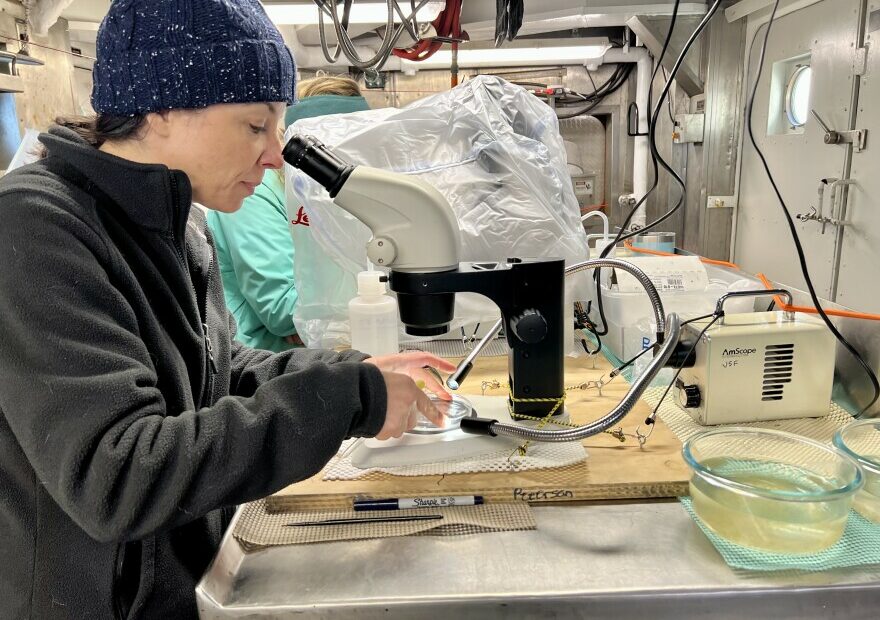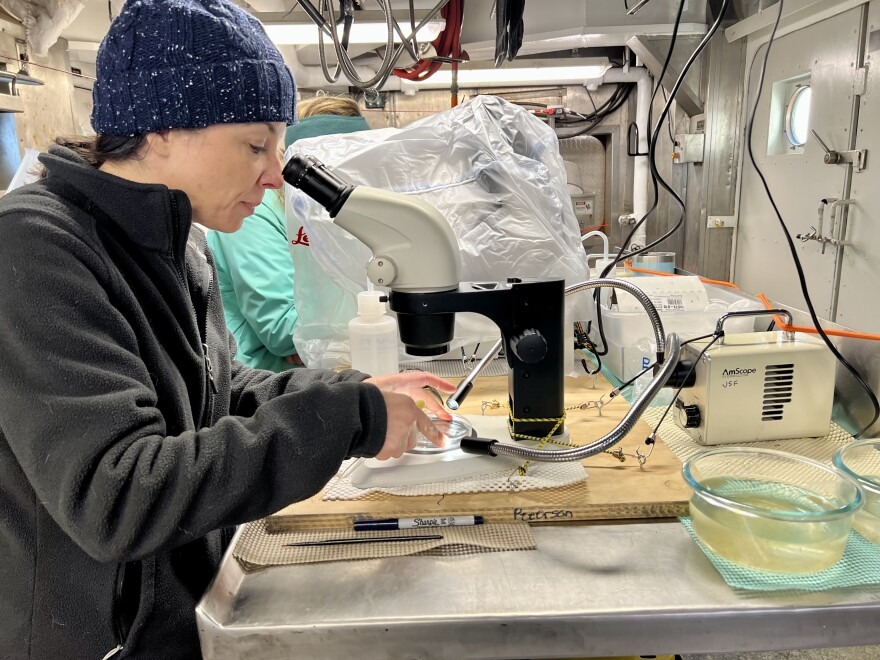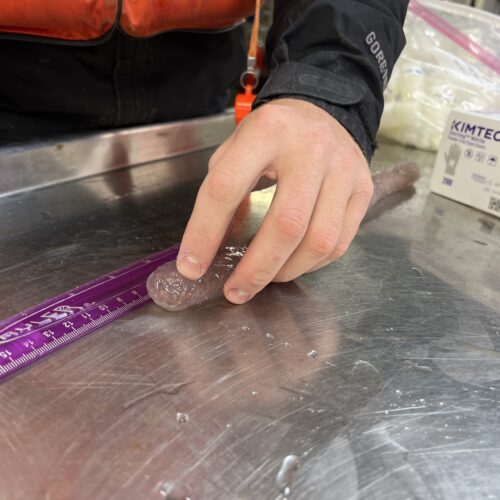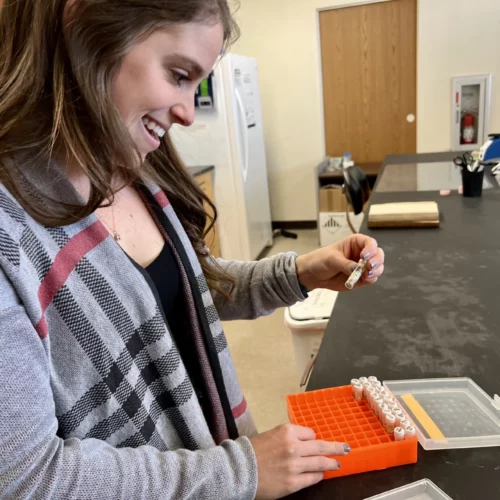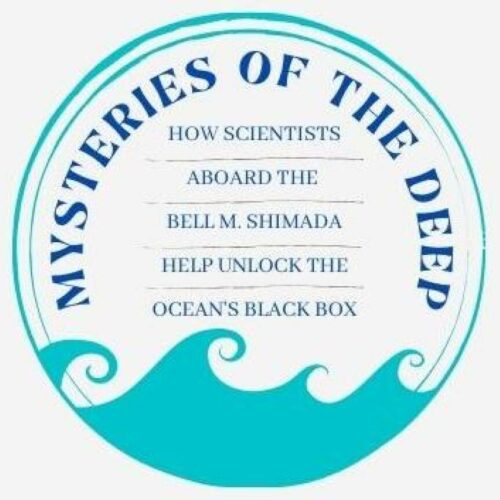These amoebas are called foraminifera, or forams (pronounced FOUR-ams) for short. And they’re everywhere.
In freshwater. On the seafloor. And all throughout the ocean’s upper waters.
That’s where Jennifer Fehrenbacher, assistant professor at Oregon State University, and Brittany Hupp, a National Oceanic and Atmospheric Administration climate and global change postdoctoral researcher at OSU, collected planktic foram samples using special nets on NOAA’s Bell M. Shimada research vessel.
Their research is part of a larger survey of the Northern California Current ecosystem that took place May 6-17. Scientists onboard the vessel hope to learn more about ocean conditions and how those conditions affect sea life, including these tiny single-celled organisms.
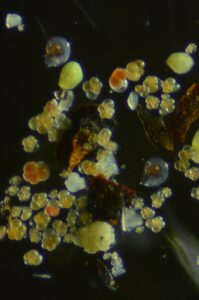
Jennifer Fehrenbacher and Brittany Hupp collected planktic forams, which look like popcorn, on the Bell M. Shimada cruise from May 6-17. CREDIT: Jennifer Fehrenbacher/ Oregon State University
The information Fehrenbacher and Hupp get from the samples could hold keys to unlocking some of the past and present effects of climate change on the ocean.
“They do a great job of recording their environment,” Fehrenbacher said, of the forams.
Forams look a little like popcorn, Fehrenbacher said, with round chambers connected to one another.
By measuring the composition of a foram shell, scientists can better understand the temperature and pH of the ocean at the time the forams grew. From that information, scientists can interpret previous ocean temperatures and the amount of carbon dioxide that was in the atmosphere, Fehrenbacher said.
In fact, foram fossil records from up to 90 million years ago have contributed to climate change models all around the world, including reports from the Intergovernmental Panel on Climate Change.
Hupp often studies foram fossils from the Paleocene-Eocene Thermal Maximum era, roughly 55 million years ago, when the earth experienced warming similar to today.
“It’s a really good analog for modern climate change,” Hupp said.
However, Hupp said, the rate of greenhouse gasses currently pumping into the atmosphere is happening about 10 times faster than the natural greenhouse gas emissions that caused the Paleocene-Eocene Thermal Maximum era millions of years ago.
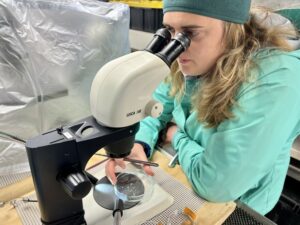
Brittany Hupp looks for planktic forams under a microscope. Scientists collected samples aboard the Bell M. Shimada from May 6-17. CREDIT: Courtney Flatt
Learning more about what happened to forams in the ocean during that time period can help scientists better predict climate change effects now, she said.
“If we perturb the global atmosphere in this way, what’s the consequence in terms of atmospheric chemistry change and ocean chemistry change? How does that affect the critters that were living at that time?” Hupp said, explaining the questions in such research.
On the Shimada, Hupp hoped to find dead or dying forams, which she could compare to fossil records.
To catch these tiny forams, crewmembers dipped a foram net into the water. Then, ever so slowly, they pulled the net back on deck. At different water depths, they collected separate samples to better understand where forams live in the ocean’s upper waters.
Sometimes Hupp and Fehrenbacher found thousands of forams. Sometimes they found barely any.
“We’re going to keep everything from these tows and then bring them back to the lab. We’ll put them in formalin, pick them, and then count them,” Fehrenbacher said.
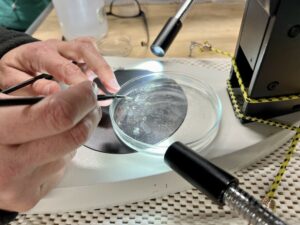
Jennifer Fehrenbacher picks forams out of water samples they collected by edging the single-celled critter onto a tiny paintbrush. CREDIT: Courtney Flatt
To pick the forams out of the water samples they collected, Fehrenbacher and Hupp placed petri dishes under a microscope.
Then, they very carefully picked each foram out of the sample by edging the single-celled critter onto a tiny paintbrush. Occasionally, for harder to scoop samples, they used a paintbrush that was plucked to only a few bristles.
“I will say, it’s much easier to pick them when you’re not on a moving boat,” Hupp said.
In addition to the dead foram samples, they placed some live forams into a culture flask, which are specially designed to grow cells. Later, Fehrenbacher will grow forams in controlled conditions.
When the planktic forams are alive, they’re quirky but beautiful creatures.
For example, the largest multinucleate foram is nine-centimeters long, which is slightly longer than a credit card, a massive size for a single-celled organism.
Moreover, Hupp said, forams are very strange, very hungry eaters. The teeny, tiny forams eat multi-celled creatures such as copepods, which also get eaten by juvenile salmon.
“It’s a 1940s blob horror movie vibe,” Hupp said.
“It’s almost gruesome,” Fehrenbacher said. “The forams dissolve copepods in minutes. It’s something out of a sci-fi movie.”
Even more visceral, Fehrenbacher and Hupp placed the dying foram samples they collected in deionized water to rinse the ocean’s salt water off, kind of like a bath. The forams practically explode, oozing any remaining cytoplasm, the gelatinous fluid inside cells.
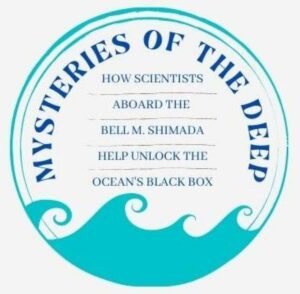
CREDIT: Courtney Flatt
“It looks like a seance, when you see old timey pictures of the essence coming out of someone,” Hupp said. “It looks like that.”
In fact, dead foram shells are so numerous, the shells make up the entirety of some deep sea sediments, Fehrenbacher said, part of why scientists have documented their fossil record so thoroughly.
Forams have so much historical information over time that it’s almost a roadmap to answer questions about climate change.
Still, Hupp said, these tiny forams could hold even more answers to questions about climate and the ocean.
“We already know a lot but there’s a lot we don’t know. I really do feel like we’re scratching the surface to learn more about past climate and ocean conditions,” Hupp said. “I’m continuously amazed.”

